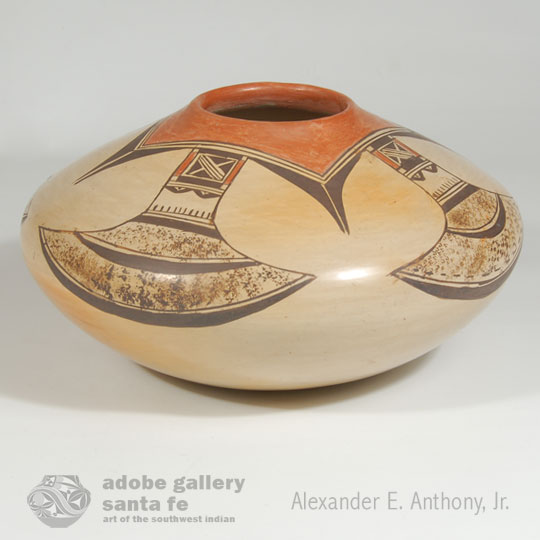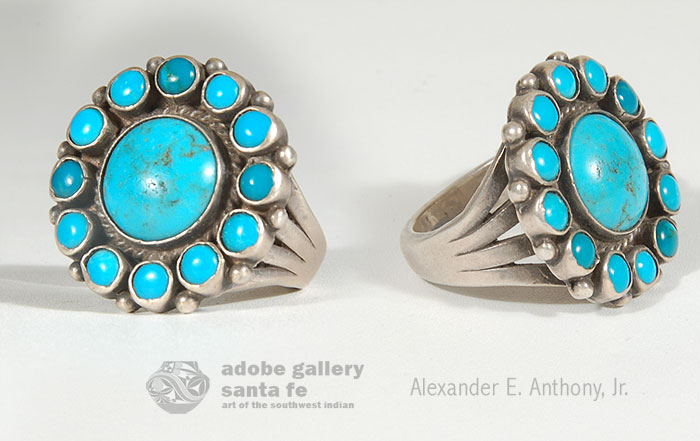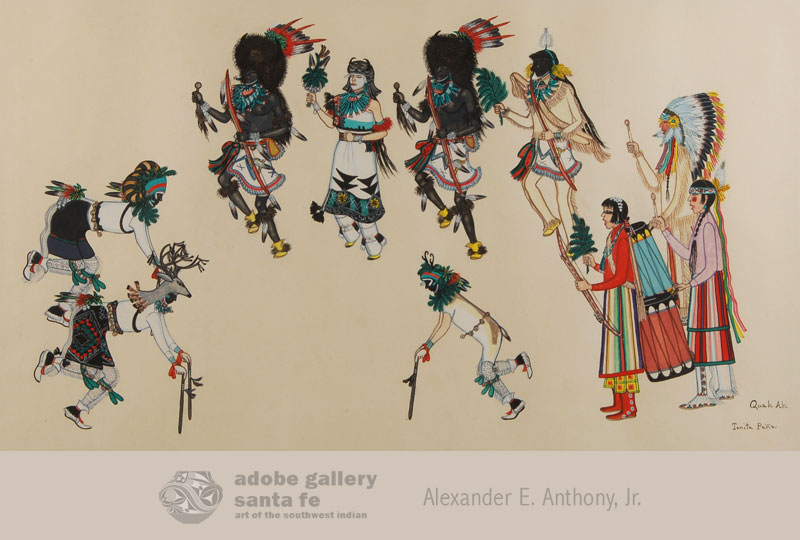San Ildefonso Pueblo Painting of a Snake Dancer by Oqwa Pi - C3883A
 There was a time, 20 years ago, or so, when everyone was welcome to visit the Hopi Reservation and witness the Snake Dance that was celebrated every two years. Now, the Snake Dance is closed to all but Native Americans. Many Pueblo and Navajo visit Hopi during Snake Dance season so it is not unusual to see a Pueblo artist paint a Snake Dancer.
There was a time, 20 years ago, or so, when everyone was welcome to visit the Hopi Reservation and witness the Snake Dance that was celebrated every two years. Now, the Snake Dance is closed to all but Native Americans. Many Pueblo and Navajo visit Hopi during Snake Dance season so it is not unusual to see a Pueblo artist paint a Snake Dancer.
Abel Sanchez (1899-1971) Oqwa Pi - Kachina Stick probably visited Hopi during Snake Dance many years ago, and painted this image from memory of the visit. It is quite likely that this was painted in the 1920s as it was painted on brown wrapping paper rather than artist paper that he is known to have used later in his career.
San Ildefonso Single Figure Female Dancer with Tableta by Tonita Vigil Peña - C3883B
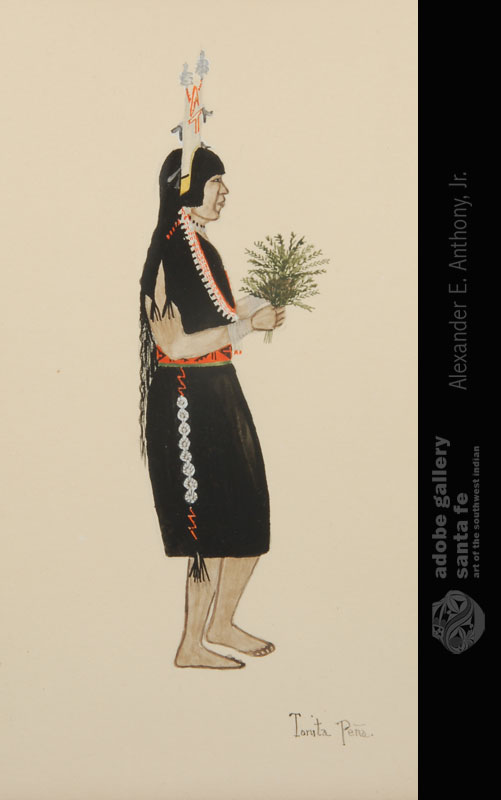 Tonita Peña was born at San Ildefonso Pueblo in 1893 and lived there with her parents until her mother passed away around 1905 when Tonita was 12 years old. Unable to tend his fields and raise a young daughter, her father sent Tonita to Cochiti Pueblo to live with her aunt and uncle. Tonita spoke Tewa, the language of San Ildefonso, and had to learn Keres, the language of Cochiti Pueblo. Having lost her mother, and essentially lost her father, and having to learn a new language and fit a society of which she was unfamiliar must have been traumatic for a young girl.
Tonita Peña was born at San Ildefonso Pueblo in 1893 and lived there with her parents until her mother passed away around 1905 when Tonita was 12 years old. Unable to tend his fields and raise a young daughter, her father sent Tonita to Cochiti Pueblo to live with her aunt and uncle. Tonita spoke Tewa, the language of San Ildefonso, and had to learn Keres, the language of Cochiti Pueblo. Having lost her mother, and essentially lost her father, and having to learn a new language and fit a society of which she was unfamiliar must have been traumatic for a young girl.
Tonita painted scenes of San Ildefonso ceremonial life as she remembered it and became a very famous painter. She is considered the very first pueblo female painter who succeeded in the male-dominated field of art. She was accepted by the men as an equal, although that probably took some time before it happened. She has also always been recognized as a painter from San Ildefonso, because that was her family home. She is never listed as an artist from Cochiti.
San Ildefonso Pueblo Snow Bird Dance Procession Painting by Gilbert Atencio - C3874V
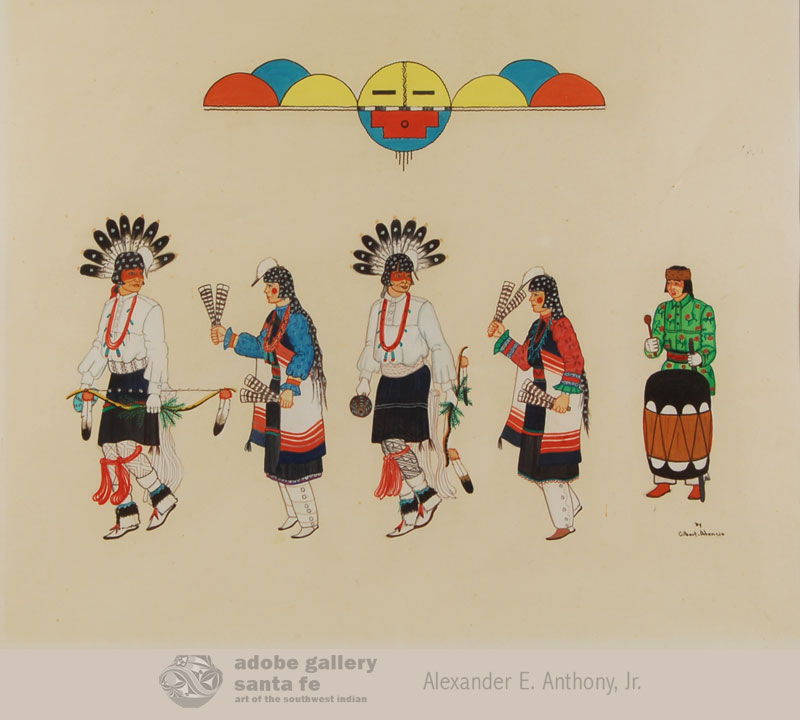 The nephew of famed San Ildefonso potter Maria Martinez, Gilbert Atencio (Wah Peen) was born in 1930. He was one of the youngest San Ildefonso painters. A student at the Santa Fe Indian School, Atencio had already had a museum show by age twenty and had garnered many awards for his work before that.
The nephew of famed San Ildefonso potter Maria Martinez, Gilbert Atencio (Wah Peen) was born in 1930. He was one of the youngest San Ildefonso painters. A student at the Santa Fe Indian School, Atencio had already had a museum show by age twenty and had garnered many awards for his work before that.
Atencio favored painting clowns and using vivid color. As he got older his attention to detail became nothing short of remarkable. He was one of the first Southwest Native artists to paint a portrait of people-his aunt and uncle, in fact-Julian and Maria Martinez. It wasn't until the 1960s that portraits became more commonplace. His later works became somewhat abstract.
Three Zuni Pueblo Shalako with Attendants Painting by Alfonso Roybal - C3874A
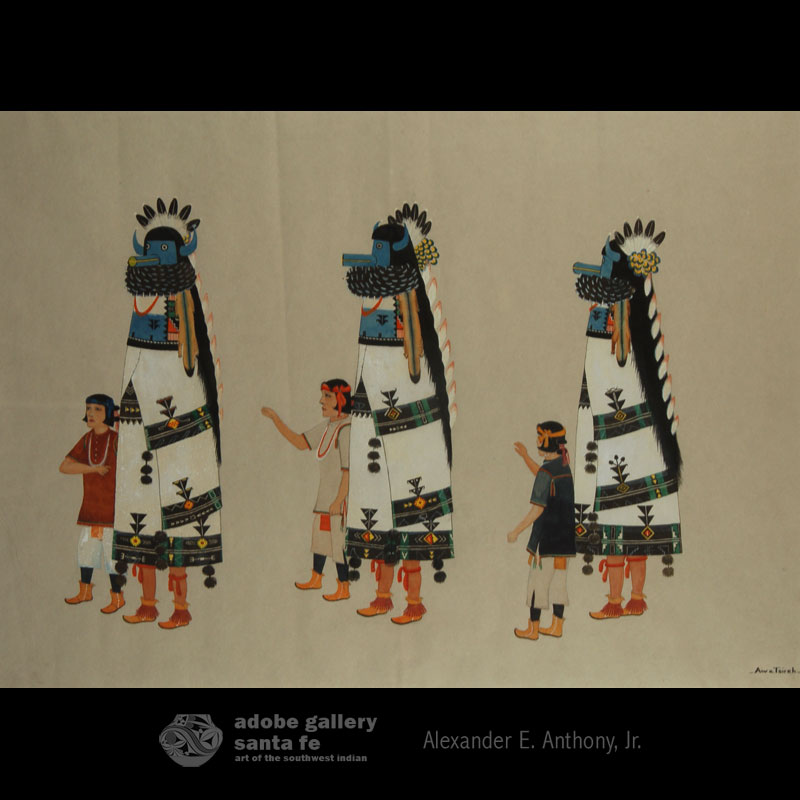 Alfonso Roybal (1898-1955) Awa Tsireh was painting before 1917, while he was still just a teenager. He was the oldest of the early group of pueblo painters. His formal education had not extended beyond primary grades. He was versatile in his styles of painting in that he was equally comfortable with representational or semi-realistic. The majority of his early work is in the Santa Fe Indian School two-dimensional style. Most of these flat-style pieces depict single figures.
Alfonso Roybal (1898-1955) Awa Tsireh was painting before 1917, while he was still just a teenager. He was the oldest of the early group of pueblo painters. His formal education had not extended beyond primary grades. He was versatile in his styles of painting in that he was equally comfortable with representational or semi-realistic. The majority of his early work is in the Santa Fe Indian School two-dimensional style. Most of these flat-style pieces depict single figures.
San Ildefonso Painting Lines of Basket Dancers by Tonita Vigil Peña - C3875B
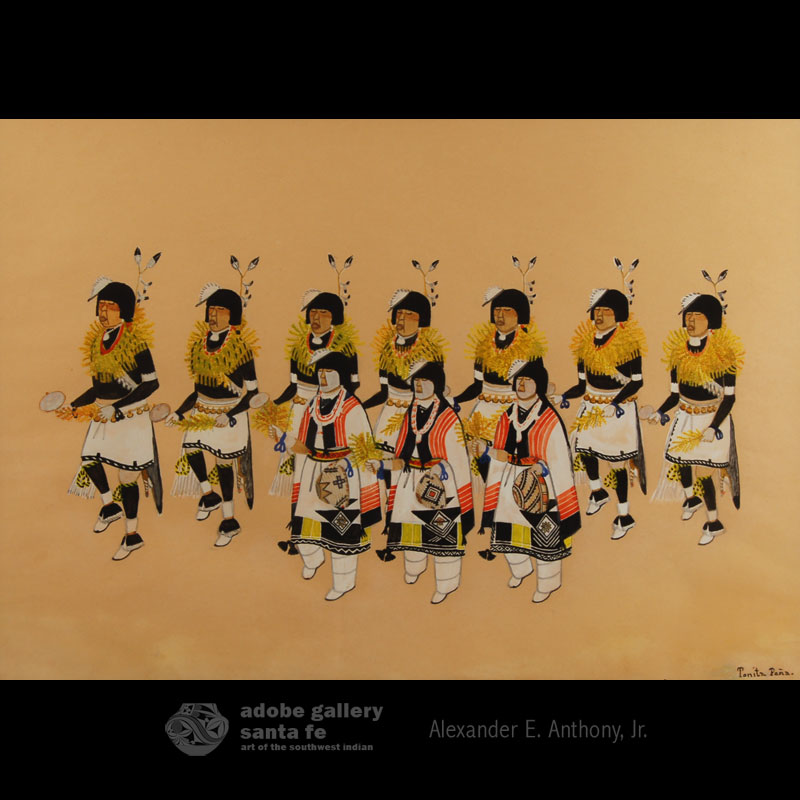 Tonita Vigil Peña (1893-1949) Quah Ah did not have an easy life. She lost her mother and sister when she was 12 years old and then her dad sent her from San Ildefonso, her native pueblo, to live with an aunt and uncle at Cochiti Pueblo, so she essentially lost her father at that time as well. She had to learn new customs, dances, songs and even a new language-Keres was spoken at Cochiti, rather than her native Tewa Language.
Tonita Vigil Peña (1893-1949) Quah Ah did not have an easy life. She lost her mother and sister when she was 12 years old and then her dad sent her from San Ildefonso, her native pueblo, to live with an aunt and uncle at Cochiti Pueblo, so she essentially lost her father at that time as well. She had to learn new customs, dances, songs and even a new language-Keres was spoken at Cochiti, rather than her native Tewa Language.
In 1908-at just 15 years old- Peña married Juan Rosario Chavez, who was 20 years old. Chavez passed away three years after their marriage. She married Felipe Herrera in 1913. He died in a work accident in 1920. Her third husband, Epitacio Arquero, outlived Tonita by a few years. They had a loving marriage and produced five children.
San Ildefonso Painting of a Pueblo Woman Carrying a Pot by Gilbert Atencio - C3874T
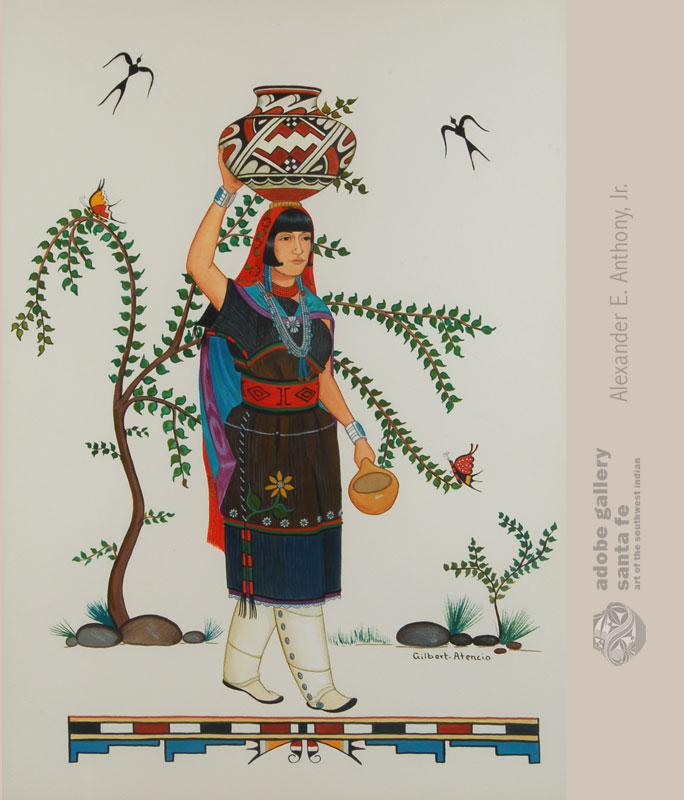 Gilbert Atencio attended the Santa Fe Indian School, graduating in 1947. His profession was as a medical illustrator at the Los Alamos National Laboratory, which is located close to the San Ildefonso Pueblo Reservation. His strong sense of family and tribal responsibility resulted in his seldom venturing from his native pueblo. The artist believed in the traditional Indian ways and his favorite subjects were ceremonies, ceremonial figures, and scenes from pueblo life. Much of his inspiration came from stories his aunts told him about their lives.
Gilbert Atencio attended the Santa Fe Indian School, graduating in 1947. His profession was as a medical illustrator at the Los Alamos National Laboratory, which is located close to the San Ildefonso Pueblo Reservation. His strong sense of family and tribal responsibility resulted in his seldom venturing from his native pueblo. The artist believed in the traditional Indian ways and his favorite subjects were ceremonies, ceremonial figures, and scenes from pueblo life. Much of his inspiration came from stories his aunts told him about their lives.
Navajo Third Phase Chief Pattern Rug - C3882A
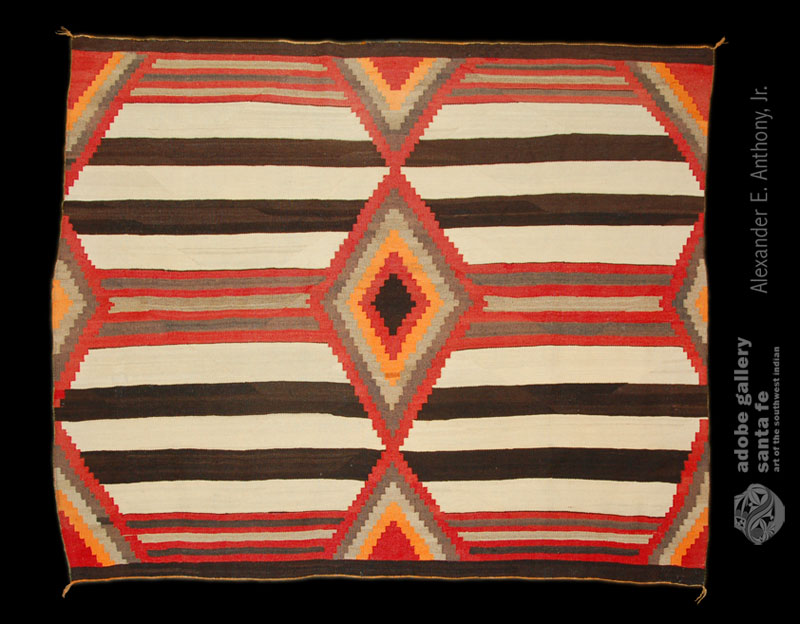 The Chief Blanket underwent several changes over the decades from 1800, among those was adding red bayeta yarn and, later, adding a total of nine triangular elements at the corners and mid part of the textile. Those changes resulted in Second Phase and Third Phase designations.
The Chief Blanket underwent several changes over the decades from 1800, among those was adding red bayeta yarn and, later, adding a total of nine triangular elements at the corners and mid part of the textile. Those changes resulted in Second Phase and Third Phase designations.
The Chief Blanket has never gone out of production. Changes were made in the early 20th century, but the appearance did not change enough to prevent use of the term, Third Phase Blanket or Rug.
This textile, a Third Phase version, is too large for a wearing blanket. It was made as a floor rug. It dates to circa 1920s. The use of orange in the textile helps set the date. The Navajo Third Phase Chief Pattern Rug is probably the most widely collected of 20th-century Navajo weavings today. The pattern, the name, the inference, all contribute to its desirability by collectors, decorators and enthusiasts.
Navajo Wide Silver Bracelet with Stamped Designs by Wayton Plummer - C3864.20
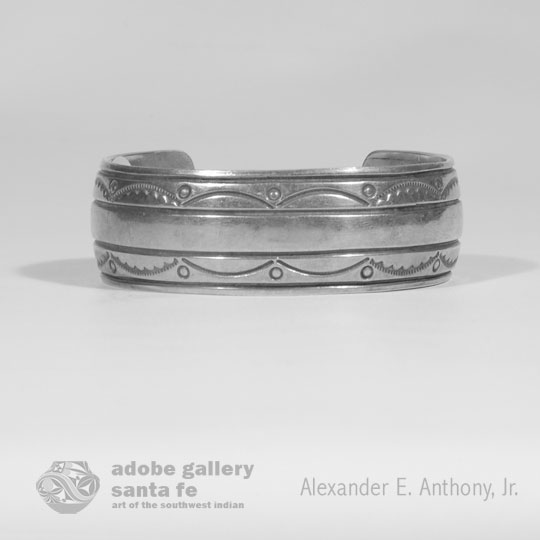 We found Earl Plummer listed in our reference books but did not find a listing for Wayton Plummer. Perhaps Wayton is a relative of Earls and lives in the vicinity of Thoreau, New Mexico. From the workmanship on this bracelet, I would not assume that Wayton is a beginning silversmith as it is well beyond what a beginner could accomplish.
We found Earl Plummer listed in our reference books but did not find a listing for Wayton Plummer. Perhaps Wayton is a relative of Earls and lives in the vicinity of Thoreau, New Mexico. From the workmanship on this bracelet, I would not assume that Wayton is a beginning silversmith as it is well beyond what a beginner could accomplish.
Best of Santa Fe Voting has Started, Vote for Adobe Gallery Today.
Click on the link below and vote for Adobe Gallery in the BEST ART GALLERY catagory!!!
#BOSF2017
San Ildefonso Pueblo Painting of an American Bison by Abel Sanchez - 25935
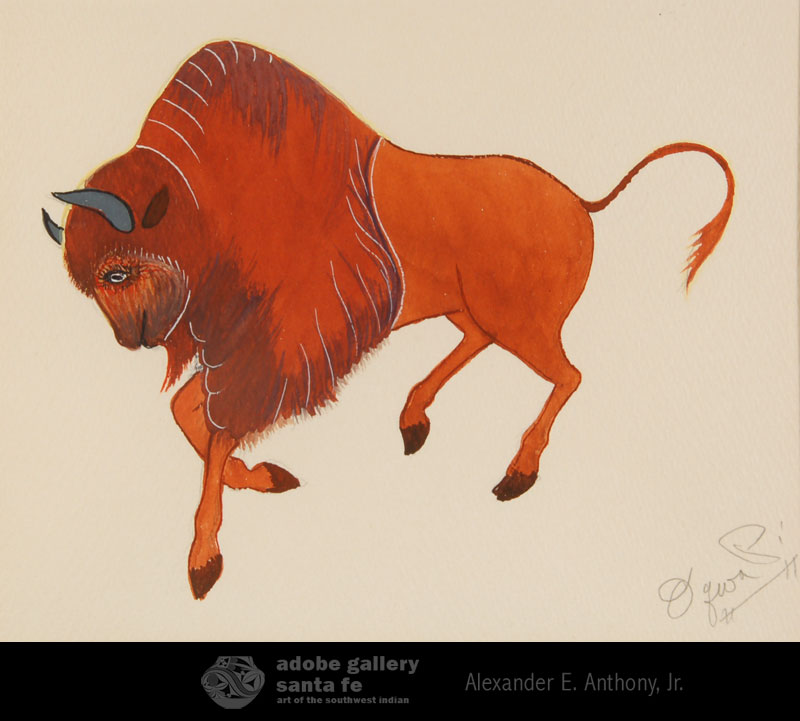 Abel Sanchez (1899-1971) Oqwa Pi - Kachina Stick was known as Oqwa Pi in the Tewa language. He was the grandfather of San Ildefonso potter Russell Sanchez. Except for what little instruction he received at the Santa Fe Indian School, he had no formal training. He was accepted as an exceptional artist and was able to raise and support a large family with his art alone.
Abel Sanchez (1899-1971) Oqwa Pi - Kachina Stick was known as Oqwa Pi in the Tewa language. He was the grandfather of San Ildefonso potter Russell Sanchez. Except for what little instruction he received at the Santa Fe Indian School, he had no formal training. He was accepted as an exceptional artist and was able to raise and support a large family with his art alone.
San Ildefonso Painting of a Pottery Design Green Parrot by Santana Martinez - C3874E
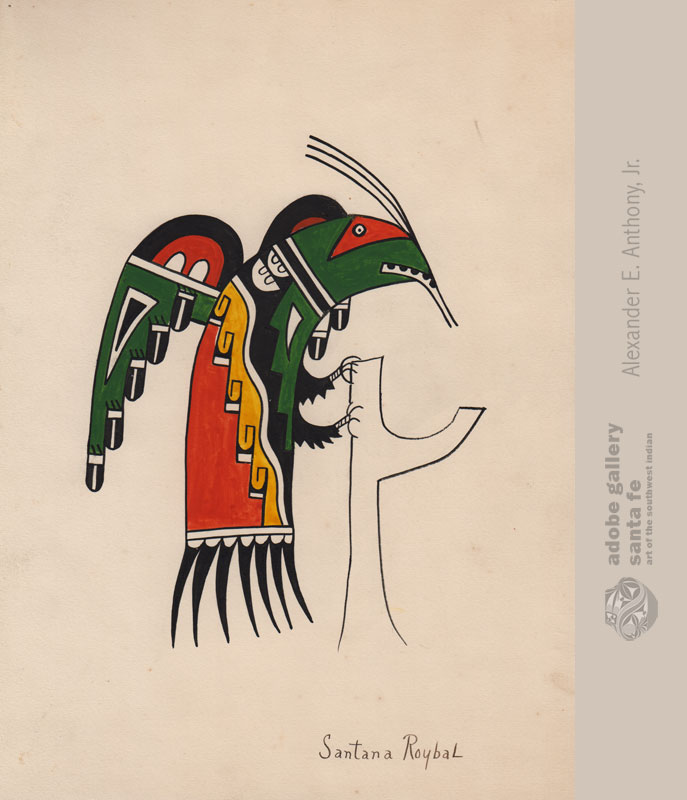 Santana Roybal, sister of Alfonso Roybal (Awa Tsireh), was 9 years old when she attended the San Ildefonso Day School in the year 1900. She studied under Esther Hoyt during Hoyt's first year of teaching at the pueblo. Santana was one of just six students in the class that first year. She and Tonita Peña were the only two girls. Hoyt provided her students with watercolor paints and paper and let them paint pictures of pueblo items and functions. This was against the government's policy of assimilating the pueblo people and divorcing them from their native ways and religion. Hoyt apparently ignored that policy. She continued as the teacher until 1907.
Santana Roybal, sister of Alfonso Roybal (Awa Tsireh), was 9 years old when she attended the San Ildefonso Day School in the year 1900. She studied under Esther Hoyt during Hoyt's first year of teaching at the pueblo. Santana was one of just six students in the class that first year. She and Tonita Peña were the only two girls. Hoyt provided her students with watercolor paints and paper and let them paint pictures of pueblo items and functions. This was against the government's policy of assimilating the pueblo people and divorcing them from their native ways and religion. Hoyt apparently ignored that policy. She continued as the teacher until 1907.
Santana eventually married Adam Martinez, oldest son of Marie and Julian Martinez. In doing so, she was destined to become a potter, which she did. Early in her life and occasionally later in life, Santana made paintings as a relief from the tedious process of pottery making.
San Ildefonso Pueblo Painting of Male Buffalo Dancer by Tonita Peña - C3874N
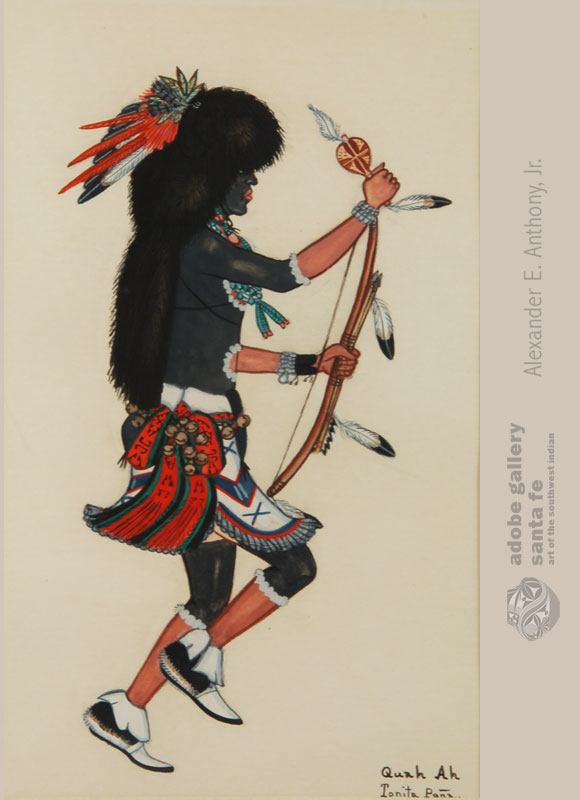 Tonita Peña was born at San Ildefonso Pueblo. At twelve years old, following the death of her mother, she was sent by her father to live with an aunt at Cochiti Pueblo. She spent the remainder of her life there. Despite living at Cochiti Pueblo, she was and is still considered an artist from San Ildefonso Pueblo. She was the only female in the group of talented early pueblo artists referred to as The San Ildefonso Self-Taught Group, which included such noted artists as Julian Martinez, Alfonso Roybal, Abel Sanchez, Crecencio Martinez, and Encarnación Peña. The men accepted her as an equal.
Tonita Peña was born at San Ildefonso Pueblo. At twelve years old, following the death of her mother, she was sent by her father to live with an aunt at Cochiti Pueblo. She spent the remainder of her life there. Despite living at Cochiti Pueblo, she was and is still considered an artist from San Ildefonso Pueblo. She was the only female in the group of talented early pueblo artists referred to as The San Ildefonso Self-Taught Group, which included such noted artists as Julian Martinez, Alfonso Roybal, Abel Sanchez, Crecencio Martinez, and Encarnación Peña. The men accepted her as an equal.
San Ildefonso Painting Dance Procession with Koosa Clowns by Alfonso Roybal - C3874K
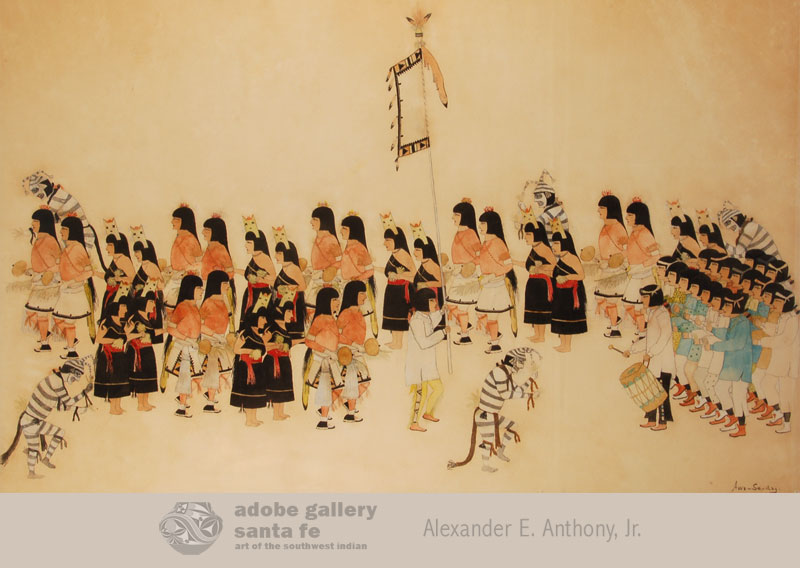
There are 53 figures in this painting, a monumental effort for a young artist of about 20 years old. It attests to the extraordinary talent of Alfonso Roybal (1898-1955) Awa Tsireh and his mastery of the watercolor medium. It is a typically two-dimensional painting but imparts a three-dimensional display. There is no ground plane, plants or elements in the sky, typical of all early pueblo paintings.
Hopi Pueblo Polychrome Seed Jar with Red Rim by Priscilla Namingha Nampeyo - C3880
Priscilla Namingha Nampeyo (1924-2008) was one of the finest of the Nampeyo family members of pottery fame. She made some magnificent very large jars and she created new designs or modified traditional designs to her tastes. She was a third-generation descendant of Nampeyo of Hano. Her mother was Rachel Namingha Nampeyo and her grandmother was Annie Healing Nampeyo. She continued using the Sikyatki revival designs taught to her by Nampeyo of Hano. She was an outstanding potter and her designs were always beautifully executed.
Navajo Silver Band with Coral Sun Flower Arrangement - C3864.17
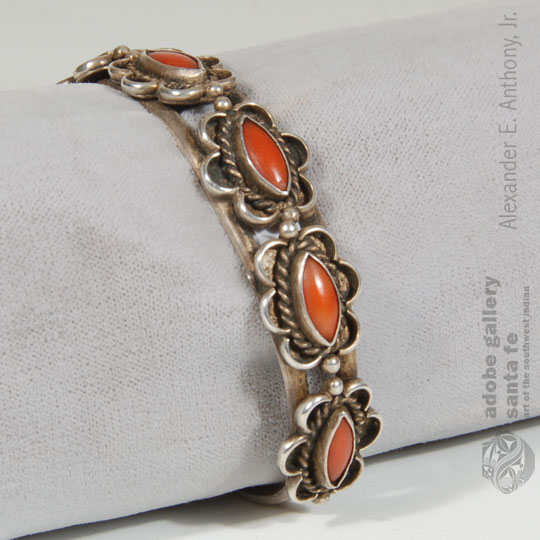 Coral was introduced to the Southwest by the Spaniards but was not used extensively until the late 1930s, when traders imported it to Zuni Pueblo. Most coral used in the Southwest came from the Mediterranean. Both Pueblo and Navajo artisans have worked with coral. This necklace is most likely of Navajo origin because of its style.
Coral was introduced to the Southwest by the Spaniards but was not used extensively until the late 1930s, when traders imported it to Zuni Pueblo. Most coral used in the Southwest came from the Mediterranean. Both Pueblo and Navajo artisans have worked with coral. This necklace is most likely of Navajo origin because of its style.
Coral reefs are under stress around the world. Coral mining, agricultural and urban runoff, pollution, overfishing, blast fishing, disease, and digging of canals and access into islands and bays are localized threats to coral ecosystems. Broader threats are sea temperature rise, sea level rise and pH changes from ocean acidification, all associated with greenhouse gas emissions. In 1998, 16% of the world's reefs died as a result of increased water temperature. General estimates show approximately 10% of the world's coral reefs are dead and about 60% of the world's reefs are at risk due to human-related activities. The threat to reef health is particularly strong in Southeast Asia, where 80% of reefs are endangered. Over 50% of the world's coral reefs may be destroyed by 2030; as a result, most nations protect them through environmental laws. Many governments now prohibit removal of coral from reefs.
Navajo Sterling Silver and Turquoise Floral Design Ring - C3864.32
Turquoise has been described as the Sky Stone and it is obvious why when viewing the beautiful blue of the turquoise in this ring. It is New Mexico sky blue. The construction of the ring's foundation was executed with precision. The shaft is solid at the base and splits into four branches at the top where it supports the floral arrangement of the turquoise.
This Sterling Silver and Turquoise Floral Design Ring was made by a master Navajo craftsman who took time to make the best possible.
Buffalo and Animal Dancers with Singers Painting by Tonita Peña - C3874M
Tonita Peña was the only woman in the group of talented early pueblo artists referred to as The San Ildefonso Self-Taught Group, which included such noted artists as Julian Martinez, Alfonso Roybal, Abel Sanchez, Crecencio Martinez, and Encarnación Peña. The men accepted her as an equal.
Like her peers, she did not use a ground plane or perspective but managed to give the illusion of depth by avoiding, whenever possible, straight lines of figures. In her dance groups, her individual figures give the appearance of being alive and moving, rather than being fixed in time or motionless as other artists of her time painted.
Comanche Dance at San Ildefonso Pueblo Painting by Julián Martinez - C3874R
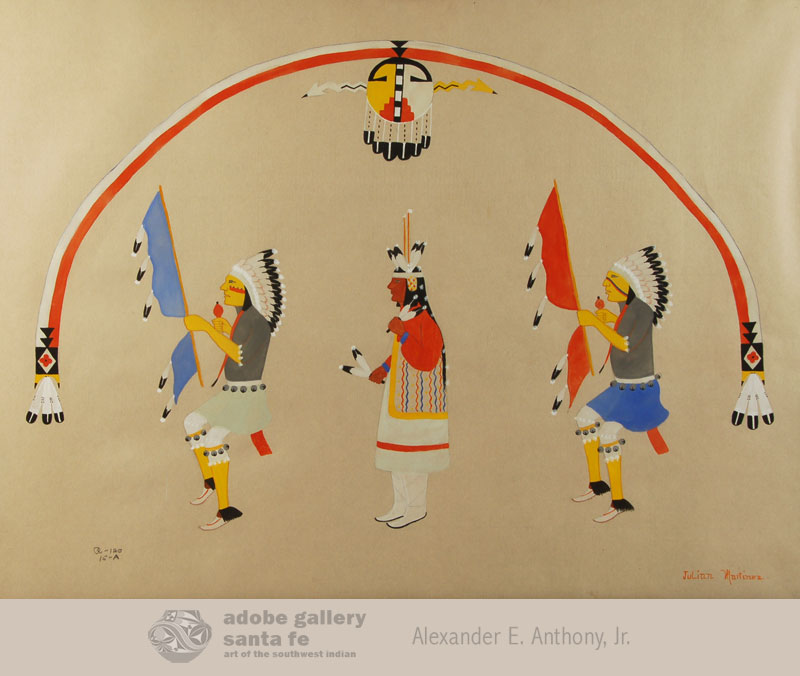 Julián Martinez (1885-1943) Pocano - Coming of the Spirits is most often associated with his wife, Maria Martinez, as the painter of her ceramics from the early 1900s until his death in 1943. He did, however, execute paintings on paper as well. He was one of the very early San Ildefonso self-taught easel artists. His watercolor paintings were a minor activity as compared to his brilliant achievements as the decorator of Maria's pottery. He was painting watercolors before 1920 and continued as time permitted until his death.
Julián Martinez (1885-1943) Pocano - Coming of the Spirits is most often associated with his wife, Maria Martinez, as the painter of her ceramics from the early 1900s until his death in 1943. He did, however, execute paintings on paper as well. He was one of the very early San Ildefonso self-taught easel artists. His watercolor paintings were a minor activity as compared to his brilliant achievements as the decorator of Maria's pottery. He was painting watercolors before 1920 and continued as time permitted until his death.
This is one of Julian's early paintings, probably from 1930. It once hung in room 1210 of Santa Fe's La Fonda Hotel. It is still in the frame in which it was at that time. Sometime, in the 1960s, the La Fonda underwent renovations and all the original Native paintings from the rooms were sold.
San Ildefonso Pueblo Mixed Animal Dance Painting by Alfonso Roybal - C3874W
Alfonso Roybal (1898-1955) Awa Tsireh, the oldest of the early group of pueblo painters, was painting before 1917 while he was still a teenager. His formal education had not extended beyond primary grades. He was versatile in his styles of painting in that he was equally comfortable with representational or semi-realistic. Most of his work is in the Santa Fe Indian School two-dimensional style, particularly his early work.
This San Ildefonso Pueblo Mixed Animal Dance painting of eight animal dancers is typical of the early works of Awa Tsireh, particularly those that were made in the 1920s. It is signed in lower right Awa Tsireh. It is watercolor on paper, and is framed with archival materials.
Painting of Chief Teaching His Son to be a Warrior by Julián Martinez - C3874Q
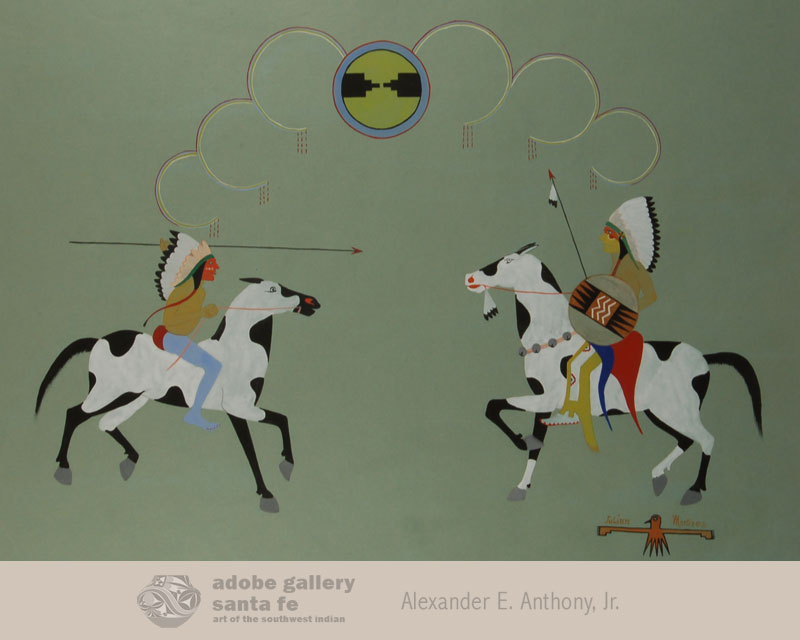 Many of Julian Martinez's paintings feature pueblo dancers, dance scenes, or animals, but this one documents a teaching experience. A father is teaching his son the ways of war or the way to be a warrior. Both father and son are on horseback, riding bareback, with proper warrior head bonnets, spears, and clothing. The younger one is on the left with his spear raised. The young man's face expresses fear or anger and the father's face expresses calm.
Many of Julian Martinez's paintings feature pueblo dancers, dance scenes, or animals, but this one documents a teaching experience. A father is teaching his son the ways of war or the way to be a warrior. Both father and son are on horseback, riding bareback, with proper warrior head bonnets, spears, and clothing. The younger one is on the left with his spear raised. The young man's face expresses fear or anger and the father's face expresses calm.



